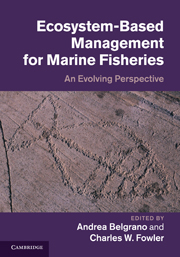Book contents
- Frontmatter
- Contents
- List of contributors
- Foreword
- Acknowledgments for cover artwork
- Introduction
- PART I CURRENT FORMS OF MANAGEMENT
- 1 Food-web and climate-related dynamics in the Baltic Sea: present and potential future applications in fish stock assessment and management
- 2 Northwest Atlantic ecosystem-based management for fisheries
- 3 Alaska marine fisheries management: advances and linkages to ecosystem research
- 4 A pragmatic approach for ecosystem-based fisheries assessment and management: a Korean marine ranch ecosystem
- PART II ELEMENTS OF IMPORTANCE TO MANAGEMENT
- PART III USING PATTERNS
- Afterword
- Index
- Plate section
2 - Northwest Atlantic ecosystem-based management for fisheries
from PART I - CURRENT FORMS OF MANAGEMENT
Published online by Cambridge University Press: 17 February 2011
- Frontmatter
- Contents
- List of contributors
- Foreword
- Acknowledgments for cover artwork
- Introduction
- PART I CURRENT FORMS OF MANAGEMENT
- 1 Food-web and climate-related dynamics in the Baltic Sea: present and potential future applications in fish stock assessment and management
- 2 Northwest Atlantic ecosystem-based management for fisheries
- 3 Alaska marine fisheries management: advances and linkages to ecosystem research
- 4 A pragmatic approach for ecosystem-based fisheries assessment and management: a Korean marine ranch ecosystem
- PART II ELEMENTS OF IMPORTANCE TO MANAGEMENT
- PART III USING PATTERNS
- Afterword
- Index
- Plate section
Summary
Abstract
The northwest Atlantic has had a rich history of living marine resource exploitation. As stocks have undergone sequential depletion with some dramatic instances of stock declines in this region, there have been calls for evaluating and improving approaches to managing our use of these resources. As part of these calls and along with recognition that there are broader issues to consider when managing a fishery, the need for more holistic ecosystem-based approaches to manage living marine resources (LMRs) have been increasingly recognized. Here we present a history of LMR management for both Canadian and US waters. We also provide contextual information for the major ecosystems in this region, with synopses and descriptions of major biophysical features in the northwest Atlantic. After noting the main data sets in this region, we discuss some of the major ecosystem models produced by our institutions. Finally, we discuss current efforts to implement ecosystem-based marine fisheries management in the northwest Atlantic.
Introduction
There have been numerous prescriptions and admonitions to implement an ecosystem-based approach to the management of fisheries (EBMF; Larkin 1996, Link 2002a, 2002b, Garcia et al. 2003, Browman and Stergiou 2004, 2005). There have been relatively few instances where such an approach has been implemented to any significant extent (Pitcher et al. 2009), but the number is growing as fisheries scientists, managers, and stakeholders grapple with the specific details of how to do EBMF. As a discipline, and as a practice, we are now moving beyond the “whys” and “whats” of EBMF (Murawski 2007) and squarely facing the “hows.”
Information
- Type
- Chapter
- Information
- Ecosystem Based Management for Marine FisheriesAn Evolving Perspective, pp. 32 - 112Publisher: Cambridge University PressPrint publication year: 2011
Accessibility standard: Unknown
Why this information is here
This section outlines the accessibility features of this content - including support for screen readers, full keyboard navigation and high-contrast display options. This may not be relevant for you.Accessibility Information
- 3
- Cited by
